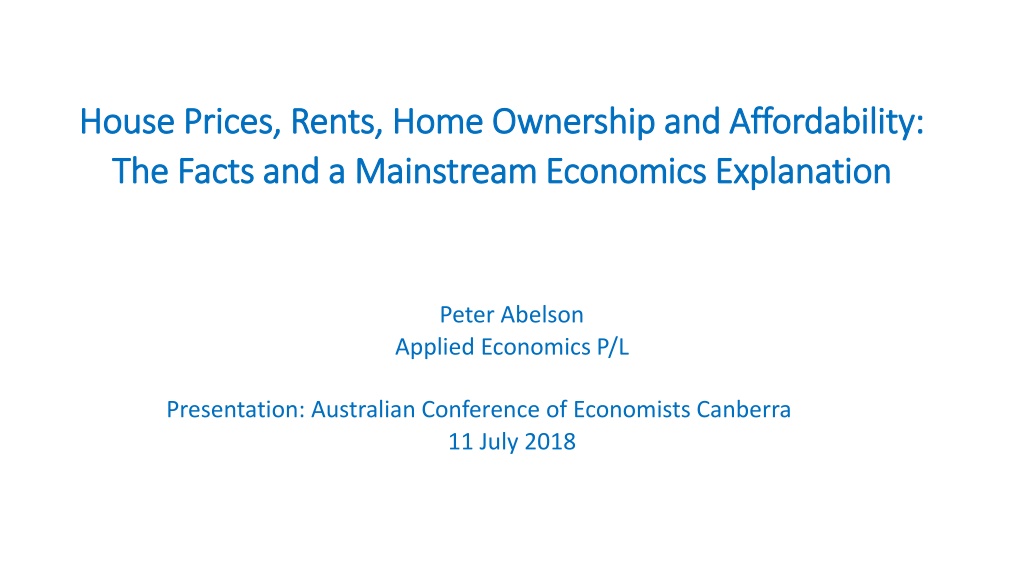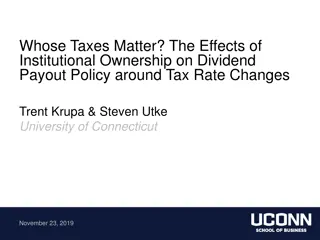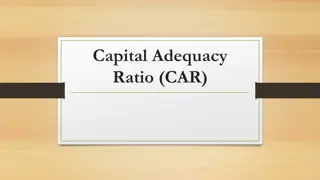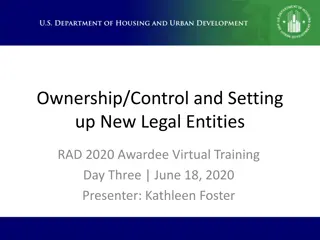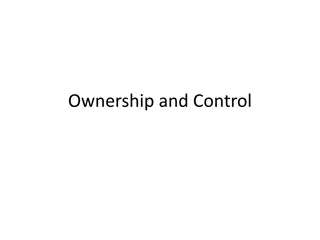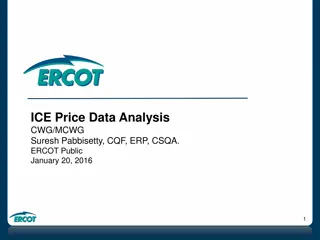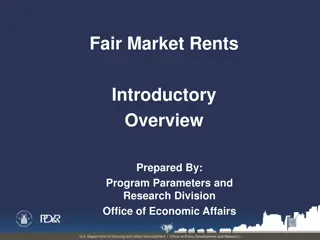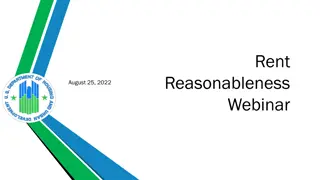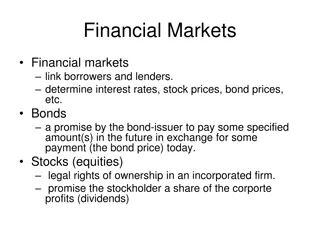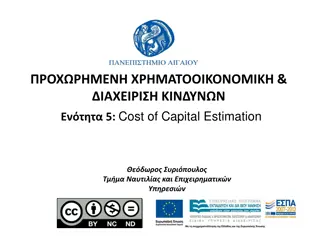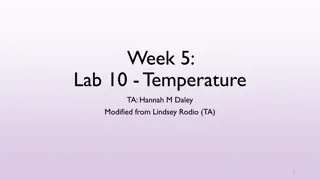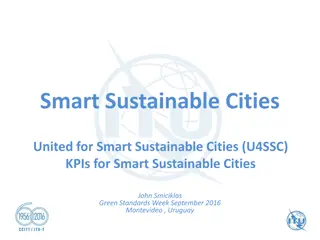Understanding House Prices, Rents, and Home Ownership Trends in Australian Capital Cities
This presentation explores the dynamics of house prices, rents, and home ownership in Australian capital cities, discussing key drivers such as population growth, housing supply, and interest rates. It highlights the challenges of housing affordability, particularly in Sydney, and offers insights into policy considerations. The data spans from 1970 to 2017, showing median nominal house prices across different cities over the years.
Download Presentation

Please find below an Image/Link to download the presentation.
The content on the website is provided AS IS for your information and personal use only. It may not be sold, licensed, or shared on other websites without obtaining consent from the author. Download presentation by click this link. If you encounter any issues during the download, it is possible that the publisher has removed the file from their server.
E N D
Presentation Transcript
House Prices, Rents, Home Ownership and Affordability: House Prices, Rents, Home Ownership and Affordability: The Facts and a Mainstream Economics Explanation The Facts and a Mainstream Economics Explanation Peter Abelson Applied Economics P/L Presentation: Australian Conference of Economists Canberra 11 July 2018
1 Presentation Outline This presentation aims to promote understanding of the nature, causes and major consequences of rising house prices. The presentation is structured is as follows: House Prices, Rents and Home Ownership: The Facts House Prices, Rents and Home Ownership: General explanations Key Drivers: Population, Housing Supply, Interest Rates and Other Drivers: Core Facts Explaining Rents, House Prices and Home Ownership Housing Affordability in Sydney Conclusions including some Observations on Policies The focus is on capital cities This is work in progress: econometric work is on-going and also trying to gain fuller understanding of housing costs for low income households. However, we believe that the main conclusions are robust.
2 Acknowledgments The presenter is part-time consultant to NSW Treasury. All views are the presenter s responsibility. Oxford Economics: Forecasting UK House Prices and Home Ownership (1992 to 2014) https://www.oxfordeconomics.com/my-oxford/projects/351906 This is an update of presentation to Sydney University 31 May 2018. Full version of this earlier presentation plus references and detailed tables is available at: www.appliedeconomics.com.au/publications/papers/index.htm This presentation will be available in Conference Proceedings.
3 House Prices, Rents and Home Ownership: The Facts House prices in Australian capital cities: 1970 to 2017 Median nominal detached house prices Median real detached house price indices Median real attached house price indices Sources 2003-2017 ABS Earlier data Valuer-General / REIA Abelson., P and D. Chung, 2005, The Real Story of Housing Prices in Australia from 1970 to 2003 , Australian Economic Review, 38, 3, pp.1-17. Housing quality ABS data are quality adjusted The data series are spliced together taking ABS data as the standard Earlier data are not quality adjusted this could overestimate price rises by 0.5% to 1.0% p.a. Summary data in next 3 slides. Full data are given as annexes in accompanying paper.
4 Capital Cities: Median Nominal House Prices ($ s, average over year) Sydney Melbourne Brisbane Adelaide Perth Hobart Darwin Canberra Year 1980 71,787 41,952 36,700 36,496 45,615 33,693 52,070 1990 202,277 139,131 116,903 98,539 114,321 76,215 100,682 140,739 2000 299,244 202,854 175,871 136,860 176,639 109,443 185,294 210,759 2003 473,630 293,130 257,600 228,100 231,750 160,330 209,630 342,280 2005 494,000 325,500 314,730 274,000 311,250 246,880 292,500 375,050 2010 603,380 494,080 405,500 405,500 507,000 344,830 534,750 527,680 2015 880,250 585,880 485,250 432,000 538,250 356,880 586,500 593,000 2016 910,000 627,500 501,250 433,280 522,250 370,080 543,750 625,500 2017 988,800 716,100 517,800 458,500 508,300 398,300 510,000 671,800 Details - See Annex Table 1
5 Capital Cities: Median Real House Price Indices (2003=100) Year Sydney Melbourne Brisbane Adelaide Perth Hobart Darwin Canberra All cities 1980 45.5 42.9 42.7 48.0 59.0 63.0 44.8 48.1 1990 58.8 65.3 62.5 59.5 67.9 65.4 66.1 56.6 61.3 2000 70.7 77.5 76.4 67.2 85.3 76.4 99.0 68.9 72.7 2003 100.0 100.0 100.0 100.0 100.0 100.0 100.0 100.0 100.0 2005 99.2 105.7 116.3 114.3 127.8 146.5 132.8 104.3 102.9 2010 104.5 138.3 129.2 145.9 179.5 176.5 209.3 126.5 129.0 2015 135.9 146.1 137.7 138.5 169.8 162.8 204.6 126.7 142.8 2016 139.1 154.9 140.8 137.5 163.1 167.1 187.7 132.3 149.8 2017 148.2 173.5 142.7 142.7 155.7 176.4 172.7 139.4 160.6 Details Annex Table 3
6 Capital Cities: Real Median Other Dwelling Price Indices (2003=100) Year Sydney Melbourne Brisbane Adelaide Perth Hobart Darwin Canberra All cities 1980 47.1 36.8 55.6 60.1 72.5 40.1 1990 51.9 58.8 62.3 70.1 64.9 77.7 52.7 2000 79.7 76.6 95.1 69.6 79.7 78.8 107.1 61.9 79.5 2003 100.0 100.0 100.0 100.0 100.0 100.0 100.0 100.0 100.0 2005 96.3 97.4 110.4 112.4 122.7 121.5 143.7 98.8 104.7 2010 102.5 130.1 137.1 146.7 173.0 136.8 259.7 116.4 132.4 2015 129.0 128.3 128.7 135.6 163.3 124.0 249.4 104.7 135.7 2016 135.5 131.0 126.6 132.7 159.2 128.2 232.7 107.4 137.3 2017 138.9 137.4 125.9 145.7 151.3 135.7 203.7 107.6 139.9 Details Annex Table 6
7 Comments There are short-term variations in house prices between the capital cities. But the long-term changes are remarkably similar across Australia. Since 2000, median detached house prices have risen less in Sydney than average of other capital cities. Median other dwelling prices have risen about the same in Sydney as average of other capital cities. Thus, changes in housing prices are a national phenomenon. The principal cause(s) of rising house prices are likely to be a national drivers / causes. As shown in Slide 8 and IMF (2018), house price inflation is also an international phenomenon.
8 International House Prices
9 Housing Rents and Incomes across Australia: 2015-16 $s Year Mean rents ($) Index 1995- 96 = 100 Mean gross HH income / week ($) Index 1995-96 = 100 Housing costs as % of HH income Average occupancy rates 1995-96 244 100 1,313 100 20 2.7 2000-01 254 104 1,430 109 19 2.6 2005-06 287 118 1,713 130 19 2.5 2009-10 349 143 1,928 147 20 2.6 2105-16 381 156 2,109 161 21 2.6 Source: ABS 4130.0 Housing Occupancy and Costs.
10 Median Housing Rents and Household Income in Sydney: 1990 to 2017 Year $ per week Real indices: 2001=100 Houses Houses Units Units Median gross household income 1990 1995 2000 2001 2005 2010 2015 2017 185 190 230 235 260 380 460 485 170 180 250 265 280 420 500 550 104.0 94.7 104.1 100.0 93.6 123.6 127.6 139.3 84.7 79.5 100.3 100.0 98.8 125.0 131.4 140.1 90.8 99.9 100.0 115.2 126.5 139.2 145.0 Notes: 2001 = 100. Middle ring results are similar for all city sales. Units are closer to CBD, so rents higher. Rents increase in line with household incomes. Much lower than house price increases. Source: FACs Rent and Sales Reports. Details Annex Tables 8 and 9.
11 Home Ownership (%) in Australia and Sydney: 2001 to 2016 2001 71.6 68.4 2006 70.4 67.3 2011 69.4 67.4 2016 68.0 64.6 Australia Sydney Source: Census data: Owned as % of owned and rented. Excludes other tenure type and tenure not stated. Average may underestimate decline in home ownership home ownership increases with age. If age profile increases, overall ownership may be constant with occupancy rates falling for all ages. On the other hand, migration / short term worker effects may reduce home ownership rate. In Sydney, Australian born residents fell from 62.2% in 2001 to 57.1% in 2016. Ideally need to sort out age and migration effects. Almost certainly, allowing for these factors, home ownership has declined. We will see the major cause: the increase in FHO deposits. UK homeownership fell from 69.3% in 2002 to 63.1% in 2014 (Oxford Economics).
12 General Explanations: Rents and House Prices Core Concepts There are two distinct concepts: living in a house and owning a house Latter is equivalent to consuming housing services and investing in a house Rents are the price of housing services Rental prices balance the supply and demand for housing services House prices are the price of owning houses House prices balance the supply and demand for housing as an asset
13 Real Housing User Cost Another key concept: the cost of home ownership is the real annual cost of the owner. This is known as the real housing user cost (RHUC) RHUC is cost of housing that leaves the owner as well off at end of year as at the start. RHUC = f(RMR, RER, D, M, PT, RCG) RMR is real mortgage rate of interest, RER is real post-tax return on own equity, D and M are depreciation and maintenance in real terms, PT is property tax, RCG is real capital gains. RHUC is all costs (and gains) of home ownership expressed in real terms. Can estimate in nominal terms and discount for inflation Repayments of mortgages are not part of RHUC - these repayments do not affect net worth. They reduce current consumption, but increase future consumption. RHUC may be calculated in absolute $s or as % of house price.
14 Drivers of Housing Rents Three main drivers of housing rents Demand (population and income) and Supply of housing Changes in house prices do not influence rents.
15 Drivers of House Prices Asset prices are the present capital value of an income stream House price = net rent / RCC (investor) or = rent / RHUC (owner) where net rent is gross rent less operating costs and RCC is the real cost of capital. This takes inflation out of both the income stream and the discount rate. Thus, changes in rents affect house prices. But house price can change without changes in rents (the price of housing services). Standard asset pricing theory if RCC (or RHUC) halves, the price of houses doubles. Analogy: one can buy clothes or invest in a clothing company. The value of the shares may rise without any increase in the price of clothing. Thus, the core drivers of house prices are drivers of rents plus borrowing (discount) rates. Population (inc. migration), income, housing supply and interest rates. Other factors: tax / subsidy changes, international demand, prudential regulations. Note: if modelling city house prices, (substitute) prices in other cities are also a driver.
16 Drivers of Home Ownership Complex topic with several drivers the presenter has not researched this in detail Demographics of potential FHOs (age structure) Earnings of potential FHOs Cost of FHO Constraints on FHO borrowing for mortgage (high LTV ratios expensive) Housing preferences (security of ownership, cf. mobility) Potential differences between native born and new migrants The balance between rents and RHUC. Renting < RHUC More renting / less home ownership and vice versa Oxford Economics Report (2016, Section 6.4) estimated these relationships for UK. They found that the home ownership rate is not affected by the supply of housing (more houses reduce RHUC and rents).
18 Population and Housing Supply: Australia Year Population (% change) Private housing (% change) Year Population Private housing 1996 18,224,000 7,175,237 1996-2001 5.76 8.57 2001 19,274,000 7,790,079 2001-06 6.11 8.17 2006 20,451,000 8,426,559 2006-11 9.24 8.19 2011-16 2016-17 8.28 1.68 8.60 2.02 2011 22,340,000 9,117,033 2016 2017 24,190,000 24,597,000 9,901,497 10,101,497 2001-16 2001-17 25.51 27.62 27.10 29.67 Sources: ABS 3101.0; Census data; 2017 estimated
19 Population and Housing Supply (Cont.) Period Population increase Private housing increase Sydney 1991 2016 36.3 41.3 Sydney 1996 2016 28.9 30.1 Sydney 2001 2016 22.3 20.1 Private housing stock generally increased by more than population across country (except for GFC blip 2006-11). Same observed for Sydney between 1991 and 2016 and between 1996 and 2016. Major exception: Sydney 2007-11 private completions were very low - just under 1% of stock. Note these figures do not include public housing data not immediately available.
20 Borrowing Rates: 1991 to 2017 Discounted mortgage rate: real RBS cash rate Standard mortgage rate Discounted mortgage rate: nominal Inflation rate Year % % June Qtr 1991 1995 2000 2005 2010 2015 2016 2017 % % % 10.52 7.50 6.25 7.72 5.50 7.30 4.75 7.27 2.00 1.75 5.40 1.50 13.42 10.50 13.22 10.30 7.52 6.80 6.75 4.65 4.60 4.50 3.2 4.6 4.5 2.7 2.9 1.5 1.3 1.8 10.0 5.7 3.2 5.1 3.8 3.1 3.3 2.7 5.45 5.25 Source: RBA. Bergman and Tran (2018) provide strong evidence that discounted mortgage rate is the common rate. In highly competitive mortgage market, borrowing rates for 80% LTV mortgage are advertised at under 4% and may be lower than RBA discounted mortgage rate. Details on rates Annex Table 7.
21 Other Factors: Taxes / Subsidies, International Demand, Regulation Taxes and subsidies: main ones have not changed in real terms over last 20 years Negative gearing rules are unchanged since 1985 1999: CGT changed from 100% on real gains to 50% of nominal gains (real + inflation) This is a concession only if real gain > inflation rate. This is recent experience. If inflation rate > real gains, the 1999 change is not concessionary. International demand has escalated. Reliable data hard to get. FIRB approvals actual purchases. And money moves in many ways. Wokker and Swieringa (Treasury Working Paper) conclude little overall impact. Lending regulations: Loan to value (LTV) ratios. Have tightened recently and almost certainly will be having current impacts. (See, for example, Atkin and Cheung, 2017). Note also the role of substitutes house prices in other Australian cities (or international cities, IMF 2018).
22 Rents: Empirical Explanations Rents = f (population, housing supply and household income) Population and housing supply increased similarly over last 20 years, broadly offsetting each other. In Slides 9 and 10, we saw that housing rents have risen almost exactly with household income (for Australia and Sydney respectively). For example, in Sydney between 2001 and 2017: Real median rent for 3-bedrom houses rose by 39% Real median rent for 2-bedroom units rise by 40%. Real median gross household income rose by 45%; Thus, real rent increases reflect primarily increases in household income. See Annex Tables 8 and 9.
23 House Prices: Empirical Explanations Simple model: House prices = f (rents, interest rates) = f (population, housing supply, household income and real interest rates) Between 2001 and 2017, in Sydney real detached house prices rose by 100% and real attached housing prices by nearly 70% - see Slides 3 and 6. Rents (i.e. population, housing supply and household incomes) accounted for 40% increase. The major factor was rise in household incomes. Over the nation, housing supply increased slightly more than population (Slide 11). Main exception was post-GFC slow down when marginal low supply may have made a small contribution to rent increase between 2005 and 2010 (and hence house prices). Most of the difference between house price and rent rises was due to fall in real interest rates as per explanation / equation in Slide 15 and data in Slide 20. Low real interest rates in early 2000 s drove house price boom 2000 to 2004. And then real rates fell from around 5% in 2007 and 2008 to around 3% from 2015 to 2017 (and possibly lower), representing a fall in the real discounted mortgage by 40%. Applying equation in Slide 15, this fall accounted for a 40% real increase in house prices between 2001 and 2017 (i.e. a substantial part of the real increase in prices). This is consistent with house price inflation as a national phenomenon.
24 House Prices: Empirical Explanations (Continued) More complex econometric modelling Abelson et al. 2005, Explaining House Prices in Australia: 1970 to 2003 , Economic Record, 81, pp. S1-S8. Major findings: Real house prices rose by 1.7% for each 1% increase in real disposable income per capita (i.e. elasticity = 1.7). A 1% fall in real mortgage rate led to a 5.4% rise in real house prices. Note this was estimated in absolute terms; it is not an elasticity estimate. This would imply that a 3% fall in real interest rates would increase real house prices by around 16%. A 1% increase in housing per capita led to a 3.6% fall in real house prices (i.e. an elasticity of -3.6). Expectations of real capital gains also explained the demand for housing (lowering RHUC) In analysis of 20 studies across 12 countries Girouard et al., (2006) found following elasticities: Real house prices to real disposable household income = 1.9 (for 20 studies). Real house prices to real interest rates = -3.1 (for 18 studies). Real house prices to housing stock = -3.1 (for 10 studies). These elasticities are similar to Abelson et al. for income and housing supply but indicate a much higher impact for changes in real interest rates. Recent structural modelling work by RBA finds that a sustained 1% drop in interest rates boosts house prices by 17% which is consistent with our finding on the previous slide (21). The RBA suggested that this higher finding may arise because Abelson et al (2005) included other variables such as stock prices that may be affected by interest rates.
25 More House Stock Price Supply Elasticities Oxford Economics (2016) found a house price elasticity of -1.8 in relation to UK housing stock. They cite (2016, Figure 20) another six refereed studies with price elasticities for housing stock between -1.1 and 2.2. They conclude that an increase in housing supply would have little impact on house prices in the UK. Critically, these estimates relate to changes in the housing stock (not to flow figures). Allowing for all these studies, a house price elasticity in the order of 2.0 to 2.5 seems a plausible average. Example: In Sydney, private housing stock is about 1.9 million dwellings. Average annual supply is about 25,000 dwellings. Increasing annual supply by 10,000 per annum (40%) would increase the housing stock by 0.5 per cent. Adopting a price elasticity of -2.5, this would reduce real house prices in Sydney by 1.25%. Achieving this for 3 years would reduce real house prices by some 3.75%.
26 City Substitutes - Inter-City Equilibrium: Another Core Issue Cities are substitutes they are not independent. Abelson / Applied Economics and Travers Morgan (1991) study found Melbourne prices followed Sydney and Adelaide followed Melbourne. Thus, above housing supply effect for Sydney requires house prices in other cities also to fall by 3.75%. At margin, similar households have equal welfare in each city (Glaeser, 2007). Welfare = f (income, commuting costs, house prices and amenity). To achieve equilibrium, house prices are higher in cities with high incomes and high amenity. Without lower prices in other cities, lower prices in Sydney would lead to more immigration into Sydney. Sydney house prices would rise and prices elsewhere fall until the inter-city equilibrium would be restored.
27 Drivers of Home Ownership As per slide 11, home ownership rates have fallen in Australia and in Sydney. Slide 16 discusses possible factors. Demographics, migrants, lower earnings of potential FHOs, constraints on FHO borrowing. I am not aware of detailed modelling of these factors. But I note two other factors: Government support for FHOs varies. Before September 2012, NSW FHO grant was $15,000 for any home up to $650,000. Now $10,000 only for new homes up to $750,000. On the other hand, FHOs now receive relief from stamp duties on low priced housing. But note: the rising cost of the FHO deposit of 20% of the dwelling price (see Slide 30).
28 Housing Affordability in Sydney: Average-Income Renters: 1995 to 2017 Year Median rent as % of median disposable household income Houses 31.3 31.3 26.2 30.3 29.4 28.9 Units 1995 2000 2005 2010 2015 2017 29.7 34.7 28.2 33.5 32.0 32.8 General picture: median rents have been broadly constant as a proportion of median household disposable income in Sydney. This is consistent with early findings (Slides 9 and 10) that showed housing rents to be a stable function of household income both across Australia and in Sydney. This confirms that housing affordability has not worsened for middle-income housing renters. (Note also that housing quality has likely increased in this data series). See Tables 8 and 9 in Annex.
29 Housing Affordability in Sydney: Low-Income Renters First Quartile Rents and Top First Quintile Income June qtr Housing 3-bedroom Unit 2-bedroom Disposable HH income Top 1st quintile as % median Rent ($) % of median rent Rent ($) % of median rent 2001 195 84.8 195 78.0 48.6 ---- 2010 330 86.8 340 80.0 49.2 2015 400 87.0 410 82.0 50.7 2016 410 87.2 420 80.8 49.4 2017 420 86.8 450 81.8 50.4 Source: FACs, Sales and Rental Reports But the situation is different for low income households. This table shows: First quartile rents (25% level) for all 3-bedroom houses and 2-bedroom units in Sydney. These rents as % of median rents. Estimated disposable household income at top of first quintile (20% level) as % of median disposable household income. See also Annex Table 10.
30 Explaining High Housing Costs for Low-Income Renters In Sydney, first quartile rents are typically between 80% and 85% of median rents. i.e. first quartile rents are only 15% to 20% lower than median rents. On the other hand, in 2015-16 $s, gross household income was $45,321 at top of 2nd decile compared with $106,742 for median household income. Allowing average tax rates of 20% and 5% respectively, households at top of 2nd decile have approximately 50% of disposable income of median household. Rent as % of disposable household income for a low-income household (R/YLYH) is given by: R/YLYH = R/YMYH 0.8/0.5 where R/YMYH = rent as % of income for medianincome household, 0.8 = rent discount and 0.5 = income discount for low-income household. This implies housing rent to income ratio = 60% higher for low-income household (at top of 2nd decile level). E.g. Low-income households pay nearly 50% of their disposable income on housing rents. These results are not precise, but indicate strongly where housing affordability is a major problem. Assuming similar distributions of rents and household incomes nationally, low income renters would be a national affordability problem (though rents are doubtless higher in Sydney).
31 Affordability for First Home Owners: Four Metrics Four metrics in relation to median FHO disposable income 1995 to 2015. 1. Interest payments on an 80% mortgage 2. Mortgage payments (principle and interest) 3. First home owner deposits 4. Real housing user costs. Assumptions underlying estimates Median FHO income = median Sydney household income. (ABS 4130.0: 55% of FHOs are > median income; 45% < median) FHO purchases a dwelling at 70% of median price in Sydney (for all Australia, the ratio is 87%) FHOs borrow 80% of house price. They have access to discounted mortgages at this LTV ratio. Note: this is a relative analysis. How have things changed? Assumptions not critical to answering this question.
32 Affordability for First Home Owners: Four Metric Results Year 2017 (right hand column) compared with 1995-2016 Average Metric 1995-2016 % of income 2017 % of income Detached dwellings Interest payments Mortgage payments First home deposit Real housing user costs All other dwellings Interest payments Mortgage payments First home deposit Real housing user costs 40.0 50.5 174.7 36.2 35.3 52.9 223.9 26.4 33.2 41.5 143.9 30.1 26.3 39.4 167.1 19.7 On three metrics, affordability in 2017 is broadly equal, or better, than average in the previous years. If FHO has savings = 20% of value of housing OR can borrow 100% at discounted mortgage rate, affordability is better in 2017 than in most years prior. Note substantial fall in RHUC. But, when neither of these conditions exist, there is a significant FHO housing deposit problem which deters FHO buyers. See Annex Table 11.
33 Affordability for First Home Owners: Four Metric Results Housing Affordability in 2017 Compared with other 22 Years 1995-2016 Metric Equally affordable in 2017 More affordable in 2017 Less affordable in 2017 Detached dwellings Interest payments Mortgage payments First home deposit Real housing user costs All other dwellings Interest payments Mortgage payments First home deposit Real housing user costs 0 0 0 0 14 6 0 21 7 16 22 1 0 1 0 0 21 17 1 22 1 4 21 0 This is another way of presenting the previous conclusions. Details, see Annex Table 12.
34 Conclusions: Rents and House Prices House rents and prices have risen nationally. This presentation discusses the causes, some consequences and policies. Rents Causes: rents reflect demand and supply for housing services = f (population, incomes, housing supply). Nationally (and in Sydney) private housing supply has risen by slightly more than population. Rents have risen broadly with (marginally less than) household incomes. Consequences: Thus median income households are spending a similar % of their income on rents - probably for improved quality housing. But rents are major problem for low-income householdsbecause the distribution of incomes is much greater than the distribution of rents. Policies: This is ongoing problem (and perhaps worsening with small increase in public housing and low low wage growth). In my view, this needs more analysis and action including more support for low income households. Dealing with this is complicated by Commonwealth / state relationships for welfare support. House prices Causes: House prices are an asset pricing issue (price = rents / cost of capital). Key driver of house price inflation (nationally and internationally) over last 18 years is fall in cost of capital: large falls in official interest rates and related borrowing rates (in the order of a 40% fall in real borrowing rates). Excessive national reliance on monetary policy. Note tax policies for housing have been largely unchanged. With borrowing rates likely to rise, house prices are likely to fall in real terms from recent peaks.
35 Conclusions: House Prices (cont.) Consequences: Using 3 metrics (interest payments, mortgage payments and real housing user costs), the cost of homeownership has been broadly constant relative to income over last 20 years. A raise in interest rates could make recent home buyers vulnerable but inflation + small real wage increases should offset small rises in interest rates. First Home Owners: consequences and policies But there are significant FHO problems as deposits (on a 80% LTV ratio) have risen in relation to income. This has likely contributed to a fall in homeownership rate. In my view, there are strong social reasons to support home ownership. One way is assistance for FHOs for low-priced housing. An issue here is whether this pushes up house prices and helps home owners more than the purchasers. But limited assistance for low price purchases should have little market impact.
36 Conclusions Role of Housing Supply Since 2001, private housing stock has increased marginally more than population (and by even more since 1996) and has had little responsibility for the house price inflation. Drawing on several econometric studies, the average house price to stock elasticity is in order of -2.5. Thus increasing housing completions in Sydney by say 40% (from 25,000 to 35,000 p.a.) for 3 years would increase housing stock in Sydney by about 1.5% and could reduce real house prices by about 4%. However, this assumes no increase in immigration to Sydney as a result. House prices in any major city can be lowered substantially only if prices fall in other cities or, if not, only by lowering its relative amenity premium. In the longer term, increasing the national housing stock significantly faster than population must lead either to falling household sizes (and likely higher costs per capita) or to significantly higher vacancy rates (which is not an efficient use of resources).
37 Conclusions Welfare and Environment We have identified two main policies: support for low income household renters and for first home owners. Housing is part of a complex urban environment. More housing may be part of the solution. But the property development industry mantra that building more houses will solve all our problems is at best simplistic and at worst rent-seeking. Without investment in infrastructure, environmental amenities and social service, greater housing density increases congestion and reduces amenity. To maximise community welfare, the trade-offs require careful and fair management. As a young Frenchman from Paris planning to settle in Sydney explained his reason to me: There are no trees in Paris !
